I had planned to join the course from the very beginning and attend all the introductory sessions synchronously. Unfortunately, the best laid plans and all that... Between travel and some unexpected projects at work, I have found myself catching up asynchronously over the weekend.
First I want to say thanks to all the instructors and participating experts who have worked so hard and with such thoughtfulness in putting this course together. I had the benefit of joining Prosolo after other intrepid souls had wandered about and asked questions about how to accomplish various tasks, so my experience there was not as confusing as it may have been for some. I think the tool has much potential and it is definitely they type of environment required for more open-ended learning. I have also appreciated the "dual" nature of the course design, which makes it a bit easier for people who haven't either the time/inclination to participate in a fully networked manner. Finally, I have found the recorded video presentations and discussions helpful.
I liked the idea of the tools matrix as well. I think this is particularly valuable as I am certain most of us taking the course have some experience with data analysis but often in areas other than learning analytics. In my case, for example, I have spent the past four years working on various projects related to price and sales analysis related to e-commerce and, in particular, textbooks. We have used a variety of database/analysis tools, ranging from MarkLogic to Tableau. We have also worked with Google Analytics, and used these tools to mine usage data related to e-textbook reading and resource access.
When I think about learning analytics, I must admit that what really interests me is learning. How can we understand the process more deeply? How can we use that understanding to improve the learning efficacy and overall experience of individual learners?
Saturday, October 25, 2014
Wednesday, October 1, 2014
Where Has All the Learning Gone?
 Another year, another EDUCAUSE.
Another year, another EDUCAUSE.Meetings. Meetings. Ah yes, a few more meetings.
Meetings and plenty of pitches from intrepid sales and marketing people eager to explain how their product is unique and will actually transform Higher Education, or at least some small portion of it.
This year, leading up to the big event, we had a long online discussion about the LMS and the ills and possible futures of learning platforms in general. For a fairly quick recap, I would suggest these posts by Brian Lamb, Tim Klapdor, and Jonathan Rees.In addition to these discussions, we also had big lead-up announcements like the one from Unizin and its founding institutional members.
Exciting times, healthy skepticism, and some potential disruption. What's not to like, right?
And speaking of disruption, Clayton Christitensen delivered the opening keynote with the message that online learning could fundamentally change the role of universities. The rest of the conference highlights/buzz, which parallel the prevailing trends and business models in Higher Education, were summarized quite nicely by Steven Mintz in his post on the future of Higher Education. His list includes: learning analytics, microcredentialing, competency-based education, personalized learning, curricular optimization, open educational resources, shared services, articulation agreements, flipped classrooms, and one-stop student services.
On the floor of the exhibit hall, the vendor booths underscored these opportunities clearly.

And more analytics.
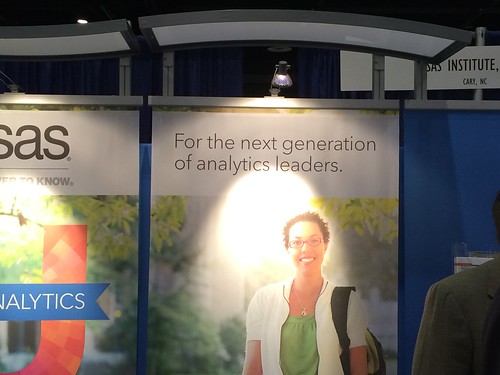
And if you want some variety...

Of course, there was also a healthy dose of...
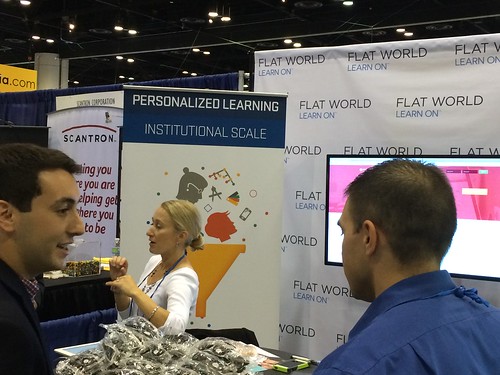
And a heaping portions of...

Naturally, there were also many smaller companies with worthy products and messages, such as...
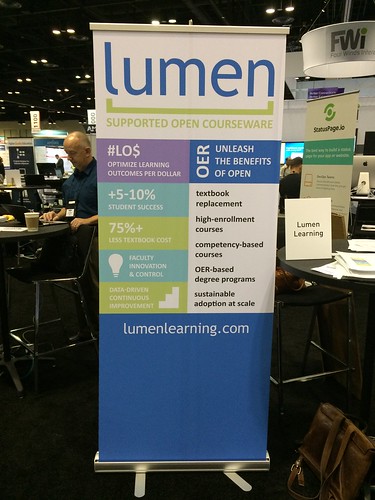
and...

and...
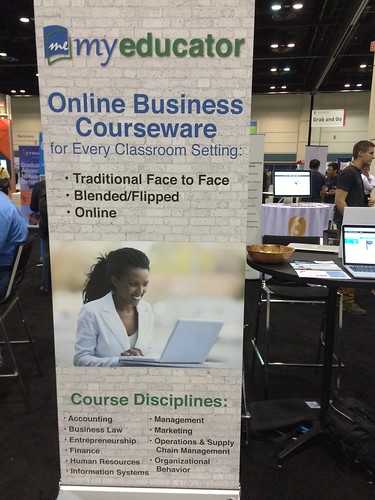
Then, somewhere in the midst of this...
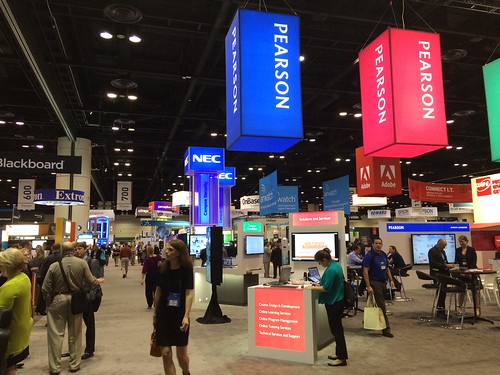
I stumbled across this ...
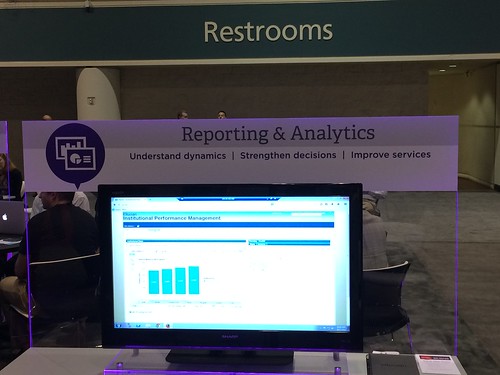
And I paused to ask myself, "What's wrong with this picture?"
The answer, at least for me, was clear. So many companies, so many products, and so many institutional solutions (almost all endorsed by institutions embracing or investing in them), all driven by the business of education. All driven by that most fundamental of business school questions -- What problem are we trying to solve?
At EDUCAUSE, it seemed evident that the problem we are trying to solve is that of making our businesses -- our institutions, companies, products -- more successful. Paraphrasing and linking the multitude of signs and signifiers on display in the Exhibit Hall, we want our businesses to be more successful in terms of user-friendliness, user retention, and user satisfaction. Judging from the many displays and demonstrations, it certainly seems that we have the technology to do these things and are devoting impressive amounts of money and human intelligence to reach our goals for success.
What problem are we trying to solve?
The question was being asked explicitly and implicitly at every presentation, booth, and meeting. It seemed that everyone had come ready to pitch their solution -- big or small -- for Higher Education, and could elucidate nicely how their solution solved an important problem in education and how it could help the bottom line (for institutions or investors).
But what problem are we trying to solve?
The question is a good one, but I felt it was being asked in the wrong context (at least for me). Instead of "What problem are we trying to solve in Higher Education?" I was wanting to hear, "What problem are we trying to solve in learning?"
That's because Higher Education, like education is general, is only a conduit for what really matters -- learning. Education, for all its temporal grandeur, is but an evolving symptom of a more important, and more fundamental human requirement -- learning. It is a container while learning is the elemental sustenance it is designed to hold.
Education is a cultural or civilizational artefact. It is tactical, linear, and concerned with corporate outcomes. It is about external achievement and measurement.
By contrast, learning is an inside-out proposition. It is about ongoing personal growth and is owned entirely by the individual learner. It can be facilitated by other learners but cannot be forced from the outside.
Education is about tangible measurements and standard outcomes, while learning resists measurement and delivers outcomes that are entirely unique for each learner.
Education is an institution and a market. It is something that can be quantified and managed. As a result, it condenses nicely into pitch decks and products that can be sold.
There is nothing wrong with that, of course. Education is a good thing and everyone I talked to at EDUCAUSE 2014 -- educators, administrators, publishers, educational technologists (institutional and corporate) -- seemed genuinely committed to and concerned about education. They were trying hard to create better containers for this thing that is learning.
But education is only a container, while learning is THE ACTUAL THING. No, learning may not lend itself to pitch-deck paradigms, but it is, ultimately, what really matters.
So I went to EDUCAUSE again and, as always, had fascinating discussions about educational technology, met really smart people with intriguing ideas, and was mesmerized by innovative products and marketing.
I also went to EDUCAUSE looking for ideas, for insights, for solutions that target the heart of our our mission, solutions that will help learners grow up and grow out.
I found much that was interesting and promising for education, but I'll admit, I left Orlando asking myself where all the talk about learning had gone.
Subscribe to:
Posts (Atom)

